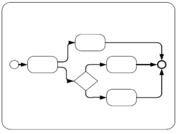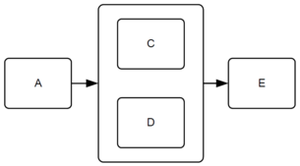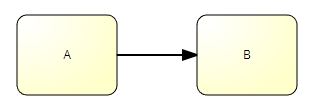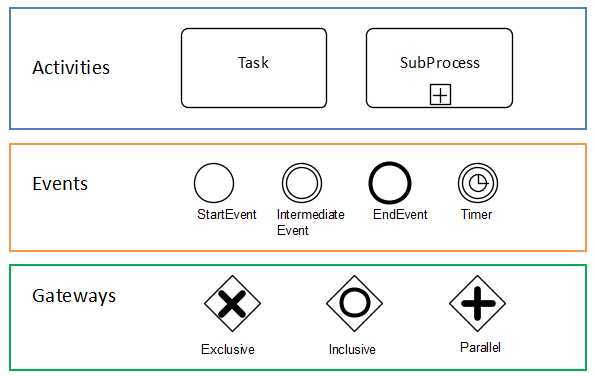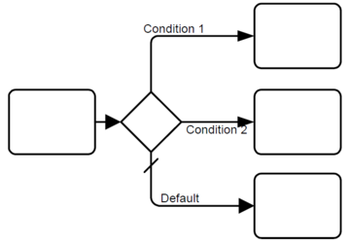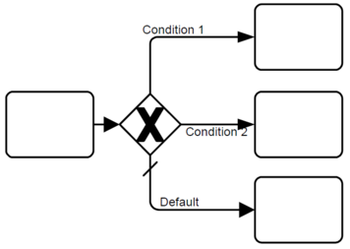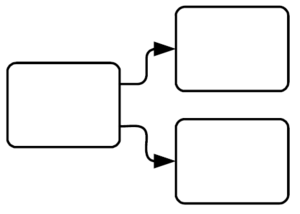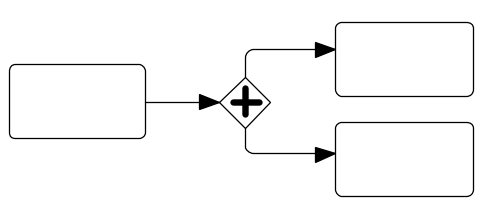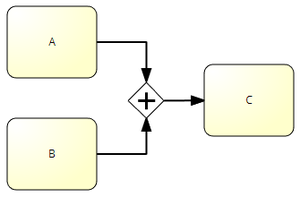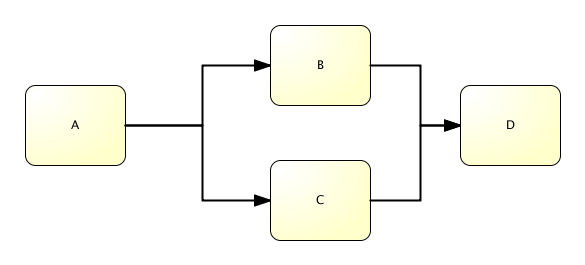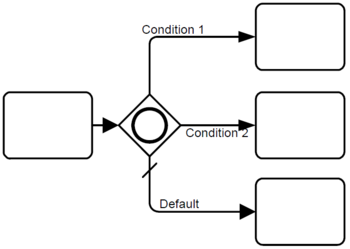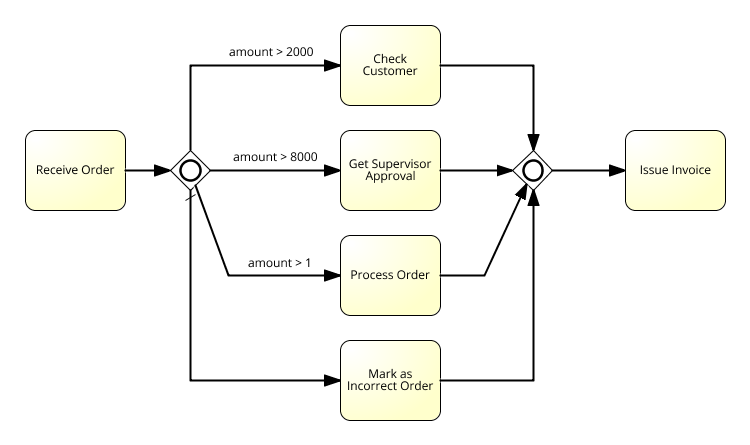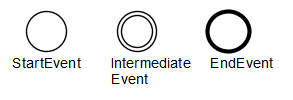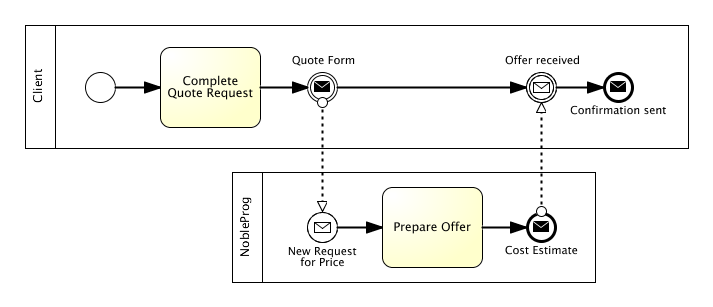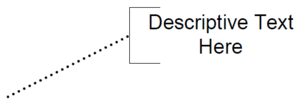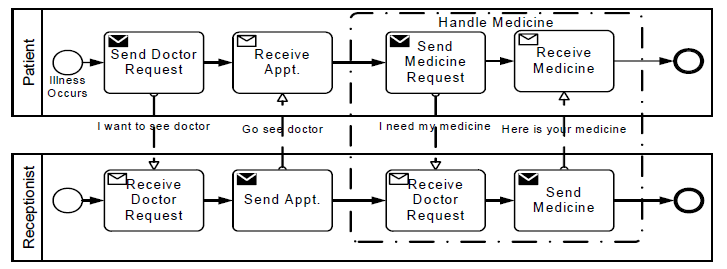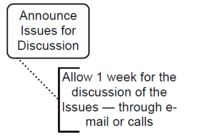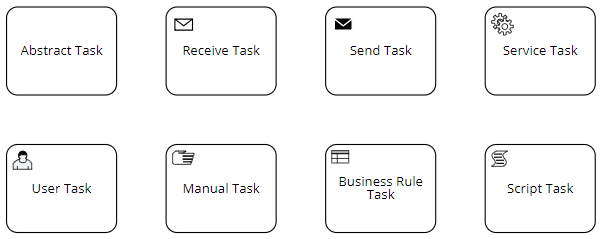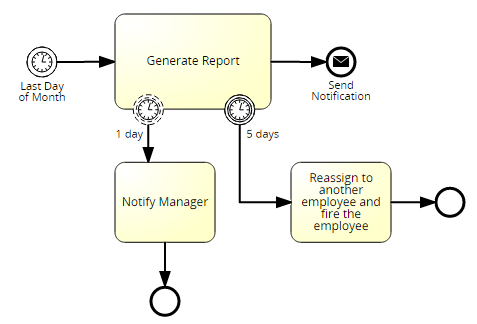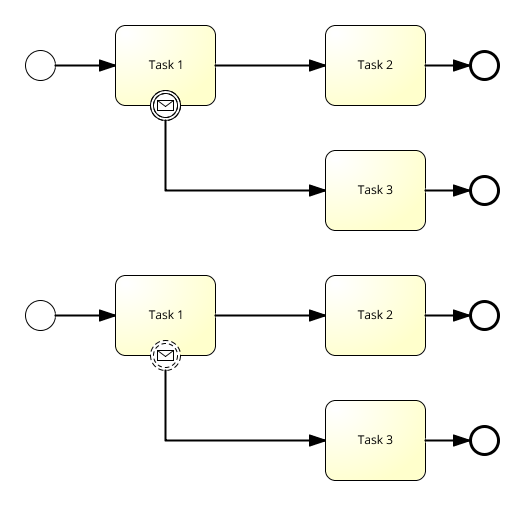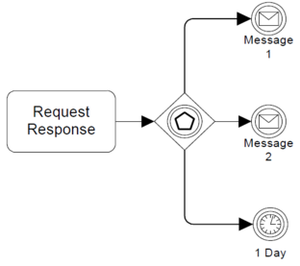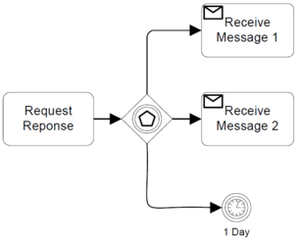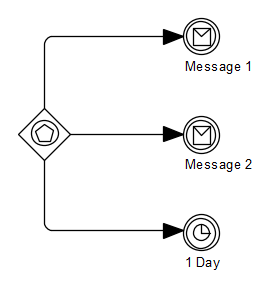BPMN 2.0 Intro Analysts Razvan
Jump to navigation
Jump to search
BPMN⌘
- Business Process Model and Notation (BPMN)
- OMG standard
- similar to flowchart diagram, but
- formal (spec)
- event based
- with message flows
BPMN Activity⌘
An Activity
- is work that is performed within a Business Process
- can be atomic or non-atomic (compound)
- represent points in a Process flow where work is performed
- is executable element of a BPMN process
Types of Activities⌘
- Task
- an atomic Activity within a Process flow
- is used when the work in the Process cannot be broken down to a finer level of detail
- Sub-Process
- compound activity
- Event Sub-Process
- Transaction
- Ad-Hoc
- compound activity
- Call Activity
- allows the inclusion of re-usable Tasks and Processes in the diagram
Types of Sub-Processes⌘
Sequence Flow⌘
A Sequence Flow is used to show the order that Activities will be performed in a Process.
Token ⌘
- Token traverses the Sequence Flows and pass through the elements in the Process
- A token is a theoretical concept that is used as an aid to define the behavior of a Process that is being performed
- The behavior of Process elements can be defined by describing how they interact with a token as it “traverses” the structure of the Process.
- A token does NOT traverse a Message Flow
Demonstration⌘
- Simple process
Sequence Flow Splitting⌘
- Conditional flow - sequence flow with a condition that is evaluated to determine whether or not the sequence flow will be used
- Default flow - used only if all the other outgoing conditional flow is not true
Basic BPMN Elements⌘
Gateways ⌘
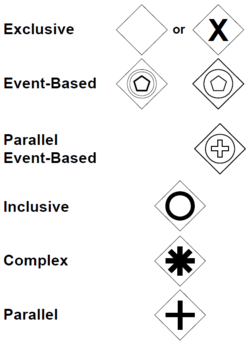
Gateways are used to control splitting and merging of sequence flows.
- do not represent ‘work’ being done
- are considered to have zero effect on the operational measures of the process (cost, time, etc.).
- two types of gateways: converge and diverge
- are optional
Exclusive Gateway ⌘
XOR Gateway
- A diverging Exclusive Gateway (Decision) is used to create alternative paths within a Process flow
- Only one of the paths can be taken, this means the gateway is exclusive
- A Decision can be thought of as a question that is asked at a particular point in the Process
- The question has a defined set of alternative answers
- Each answer is associated with a condition Expression that is associated with a Gateway’s outgoing Sequence Flows
Exclusive Gateway Example⌘
Parallel Gateway ⌘
AND Gateway
- A Parallel Gateway is used to synchronize (combine) parallel flows and to create parallel flows
- A Parallel Gateway creates parallel paths without checking any conditions; each outgoing Sequence Flow receives a token upon execution of this Gateway
- For incoming flows, the Parallel Gateway will wait for all incoming flows before triggering the flow through its outgoing Sequence Flows
Parallel Gateway Example 1⌘
Parallel Gateway Example 2⌘
Gateway Exercises⌘
- Demonstration - splitting and merging
Inclusive Gateway ⌘
OR Gateway
- A diverging Inclusive Gateway (Inclusive Decision) can be used to create alternative but also parallel paths within a Process flow
- Unlike the Exclusive Gateway, all condition Expressions are evaluated
- The true evaluation of one condition Expression does not exclude the evaluation of other condition Expressions
- All Sequence Flows with a true evaluation will be traversed by a token
- Since each path is considered to be independent, all combinations of the paths MAY be taken, from zero to all
- However, it should be designed so that at least one path is taken.
Inclusive Gateway Example 1⌘
Inclusive Gateway Example 2⌘
Events ⌘
An Event is something that “happens” during the course of a Process.
- These Events affect the flow of the Process and usually have a cause or an impact. The term “event” is general enough to cover many things in a Process.
- The start of an Activity, the end of an Activity, the change of state of a document, a Message that arrives, etc., all could be considered Events
- Three types of events:
- Start Events - indicate where a particular Process will start
- Intermediate Events - indicate where something happens (an Event) somewhere between the start and end of a Process
- End Events - indicate where a Process will end
Events Example⌘
Events Exercises⌘
Pool and Participant⌘
- The pool shape represents a participant.
- A Lane is a sub-partition within within a Pool.
- Lanes are used to organize and categorize Activities.
- The meaning of the Lanes is up to the modeler.
- Lanes are often used for such things as internal roles (e.g., Manager, Associate), systems (e.g., an enterprise application), an internal department (e.g., shipping, finance),
Message Flows ⌘
- A Message Flow is used to show the flow of Messages between two Participants that are prepared to send and receive them.
- A Message Flow MUST connect two separate Pools. They connect either to the Pool boundary or to Flow Objects within the Pool boundary. They MUST NOT connect two objects within the same Pool.
Demonstration ⌘
- Pool, Lane, Blackbox
4 Basic Message Events ⌘
Four basic message event types.
Message Events Example⌘
Collaboration Exercises⌘
Artifacts ⌘
Artifacts are used to provide additional information about the Process
Group ⌘
- Provides a visual mechanism to group elements of a diagram informally.
- Group can be used for documentation or analysis purposes.
- Groups do not affect the flow of the Process.
Text Annotation ⌘
- Is a mechanism for a modeler to provide additional information for the reader of a BPMN Diagram
- The Text Annotation object can be connected to a specific object on the Diagram with an Association
- Does not affect the flow of the Process
Types of Tasks ⌘
Receive Task ⌘
- Waits for a Message to arrive from an external Participant
- Once the Message has been received, the Task is completed
- Starts the process
- MUST NOT have any incoming Sequence Flow
- Instantiate attribute MUST be set to true
Send Task ⌘
- Sends a Message to an external Participant.
- Once the Message has been sent, the Task is completed.
Service Task ⌘
- uses some sort of service, which could be a Web service or an automated application.
User Task ⌘
- A typical “workflow” Task where a human performer performs the Task with the assistance of a software application
- Examples:
- Phone operator updates customer record
- User changing their password
Manual Task ⌘
- Is expected to be performed without the aid of any business process execution engine or any application
- Example:
- A telephone technician installing a telephone at a customer location
Business Rule Task ⌘
- Provides a mechanism for the Process to provide input to a Business Rules Engine and to get the output of calculations that the Business Rules Engine might provide
Script Task ⌘
- Is executed by a business process engine
- The modeler or implementer defines a script in a language that the engine can interpret
- When the Task is ready to start, the engine will execute the script
- When the script is completed, the Task will also be completed.
Timer Events ⌘
- Expresses a time gap in processing or a wait for a period of time.
- Start Timer – start on specific date (Monday at 9am, etc..)
- Intermediate Timer - a specific time-date or a specific cycle (e.g., every Monday at 9am)
- If used in the main flow it acts as a delay mechanism
Timer Example 1⌘
Timer Example 2⌘
Interrupting vs. Non-Interrupting⌘
Conditional Events ⌘
- Is triggered when a condition such as "Temperature above 20°C" become true.
Event-Based Exclusive Gateway⌘
- The Event-Based Gateway represents a branching point in the Process where the alternative paths that follow the Gateway are based on Events that occur
- This is opposed to the evaluation of Expressions using Process data (as with an Exclusive or Inclusive Gateway which are Data Based)
- A specific Event, usually the receipt of a Message, determines the path that will be taken
- Basically, the decision is made by another Participant, based on data that is not visible to Process, thus, requiring the use of the Event-Based Gateway.
Example⌘
- A company is waiting for a response from a customer they will perform one set of Activities if the customer responds “Yes” and another set of Activities if the customer responds “No.”
- The customer’s response determines which path is taken
- The identity of the Message determines which path is taken
- That is, the “Yes” Message and the “No” Message are different Messages
- The receipt of the Message can be modeled with an Intermediate Event with a Message trigger or a Receive Task
- In addition to Messages, other triggers for Intermediate Events can be used, such as Timers

